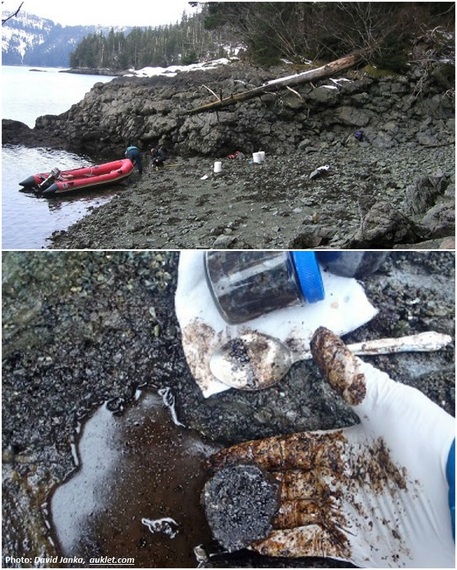Monday marked the 25th anniversary of the Exxon Valdez oil spill, one of the most devastating environmental disasters in America history, and that makes the events of the last few days all the more chilling. Saturday afternoon, the U.S. Coast Guard received word of yet another potential disaster just off the coast of Texas City, Texas -- a barge carrying nearly one million gallons of heavy tar-like oil collided with another ship, spilling as much as a quarter of its cargo into the Houston Ship Channel and Galveston Bay.
Cleanup crews have been dispatched in the Gulf of Mexico, but it might be years before the true damage to local fish and wildlife populations can be assessed.

Exxon Valdez oil lingers in shoreline sediments, Herring Bay-Knight Island-Prince William Sound, taken on Feb. 18, 2014.
Twenty-five years prior, on March 24, 1989, an oil tanker, the infamous Exxon Valdez, struck a reef off the coast of Alaska. The Valdez was carrying 53 million gallons of thick, dark, toxic crude oil -- nearly 11 million gallons of the nasty stuff was sent gushing into Prince William Sound. Oil coated more than 1,000 miles of beaches. The toll taken on local wildlife was at once unbelievable and heartbreaking. The toll taken on local communities, fisheries and economies was just as dramatic. Today, residual oil -- a (conservative) estimate suggests at least 21,000 barrels worth -- still lurks just beneath the surface of Prince William Sound beaches, adversely impacting both wildlife and human lives to this day.
So when Shell's Kulluk drill rig ran aground near Kodiak Island in Alaska on New Year's Eve 2012, it was a chilling reminder to Alaskans and people around the country of the horrific consequences of one of the largest oil spills in U.S. history. The Deepwater Horizon disaster, which occurred less than four years ago, is another stark illustration of the devastating impacts that occur from an oil spill.
The point, of course, is that oil companies continually tell us that they have figured out how to prevent oil spills; that they can be trusted to work safely and cleanly in any environment. But history tells us spills happen -- not only those like the Exxon Valdez or Deepwater Horizon, but smaller spills like this weekend's Texas City incident -- that are terribly damaging nonetheless. Whether it's human error, mechanical malfunction or a simple act of Mother Nature, the fact is that it's not a question of if another spill is going to happen. It's a question of when. Safety isn't guaranteed -- only broken promises are.
Today, all eyes are on Alaska again. The Arctic Ocean is the next frontier that the oil industry is seeking to exploit; its severe weather and icy seas complicated by the fact that there is infinitely less infrastructure or spill-response capability in place when compared to Prince William Sound or the Gulf of Alaska. And once again, history says that the evidence is clear: oil companies cannot operate safely in as harsh and demanding a place as the Arctic Ocean.
Shell's 2012-2013 drilling season revealed the force of Mother Nature, the harshness and uncertainty of the Arctic climate and Shell's incompetence. On December 31, 2012, the true challenge of drilling in the Arctic began to play out on a national stage. America watched transfixed as Shell's drilling rig, the Kulluk, ran aground off the coast of Kodiak Island, Alaska. Soon after, a Freedom of Information Act request revealed that Shell's oil spill containment dome was "crushed like a beer can" during routine testing in waters exponentially calmer than those found in the Arctic.
The Kulluk incident was the icing on the cake, as a laundry list of 2012 Shell mishaps included having its drilling rig, the Noble Discoverer, slip anchor and run aground, beginning preparatory drilling in Alaska's Chukchi Sea in September 2012, only to have to stop a day later as a 10-by-30-mile ice floe moved towards the drill site; and backpedaling on its claim that it could clean up 95 percent of oil should a spill occur in the Arctic.
Those failures prompted Shell to cancel its plans to drill in 2013. This past January, Shell officially confirmed that it will not be drilling in the Arctic Ocean in 2014, either. Perhaps spending $5 billion in the Arctic with no results to speak of finally prompted the company to admit it had "bitten off more than it could chew," according to a Wall Street Journal editorial.
We certainly hope this is a sign that the oil industry has learned its lesson (though chances are Shell will still make a go of it in 2015), and that Shell's debacles in the Arctic have caused the U.S. government to reexamine drilling there. After all, the Arctic Ocean supports some of the world's most iconic wildlife species, such as beluga whales, polar bears, walruses and ice seals. And the consequences due to the continuing decline in sea ice caused by climate change are being felt not just in the Arctic, but worldwide. Destroying irreplaceable habitat and introducing even more fossil fuels into the world's climate should be off the table.
Yet history also tells us that greed is a powerful motivator: if there's profit to be made with Arctic oil, someone, somewhere, will try to exploit it. We cannot risk this remote and beautiful place to further our addiction to oil and gas.
